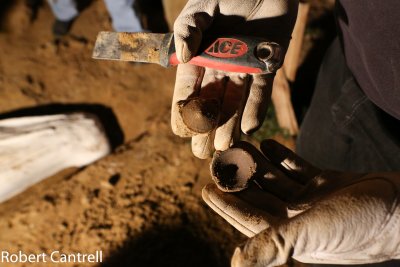
A final shark vertebra unearthed Halloween night. Photo by R. Cantrell.
SOLOMONS, Md.—Calvert Marine Museum (CMM) paleontologists excavated an extremely rare fossilized skeleton of a 15-million-year-old shark on October 31, 2014. Uncovered by the Gibson family on their property in Chesapeake Beach Maryland, this snaggletooth shark skeleton is the first of its kind ever found.
Shawn Gibson contacted Dr. Stephen Godfrey, Curator of Paleontology at CMM, about a fossil find that his brother, Donald, discovered. Donald found fossil shark vertebrae while digging footers for a new sunroom at the home of his parents, Donnie and Jo Ann Gibson. He contacted Pat Gotsis, a family friend who has collected fossils for over 40 years. Pat knew immediately it was something special. After a day of digging, Shawn, with help from his 7-year-old son Caleb, excavated over 50 vertebrae. When they realized that the vertebrae led up to the shark’s skull with jaws full of teeth, Shawn called the museum for help.
Shawn Gibson’s phone call describing their find was so unusual that John Nance, Assistant Curator of Paleontology, and Dr. Godfrey investigated immediately. “We were wonderstruck at seeing the articulated shark skeleton!” said Dr. Godfrey.
Aside from their teeth, shark skeletons are made of cartilage, which does not fossilize nearly as well as bone. Typically after animals die if parts of their skeleton do not disintegrate immediately, they are scattered by scavengers. In this case, most of the teeth and skeleton stayed together in a life-like way as it became buried in sand on the ocean floor.
Godfrey told those gathered that he had never seen anything like it and would probably not live long enough to see another. “We are very grateful that the Gibson’s stopped digging when they did and called the museum for help.” The rest of the skeleton was excavated that evening and trick-or-treater’s watched as the team worked to put a protective cast around the fossilized shark skeleton. Robert Cantrell (AllFinsOn.com) filmed and photographed the excavation and the skeleton is now at the Calvert Marine Museum where it will be prepared for display and research.
This skeleton, the first one of this kind of shark ever found, belongs to the extinct snaggletooth shark, Hemipristis serra. Over 80 vertebrae and hundreds of teeth from one individual were found. The shark would have been 8 to10 feet long. The jaws and teeth were preserved mostly intact after the shark came to rest upside down on the ocean floor 15 million years ago during the Miocene epoch. Even more astounding, is the presence of delicate jaw cartilage which is almost never preserved.
The closest living relative to this extinct Miocene shark is also known as the snaggletooth or weasel shark (Hemipristis elongata; Family Hemigaleidae). It is found in the Indo-West Pacific, including the Red Sea, from southeast Africa to the Philippines, north to China, and south to Australia, in coastal waters at depths of 4 to 400 feet. The living snaggletooth shark grows up to 8 feet in length, and preys upon crabs, cephalopods, other sharks, rays, and fish. The teeth of the extinct snaggletooth shark are so similar to those of its living relative that they probably had a comparable diet.
Additional information:
During the Miocene epoch, global climate was warmer on average than it is today and polar ice caps were smaller to non-existent. That extra water in the oceans flooded low-lying continental areas. At that time, much of the coastal plain was covered by the Atlantic Ocean. For millions of years, sediments eroded from the Appalachian Mountains were carried by rivers flowing into the Atlantic Ocean and laid down over the coastal plain (then the Miocene sea floor) entombing trillions of fossils in the process, including the snaggletooth shark just found.
More than 600 species (most of which are extinct) have been identified as fossils from along Calvert Cliffs. These include the fossilized remains of microorganisms like diatoms, dinoflagellates, and foraminiferans, and of larger organisms like corals, mollusks, crustaceans, barnacles, echinoderms, sharks and rays, bony fishes, turtles, crocodiles, birds, seals, sea cows, dolphins and whales, and fragmentary remains of large terrestrial mammals (peccaries, rhinos, antelope, camels, horses, and gomphotheres - an extinct group of elephants).
Source: Calvert Marine Museum


